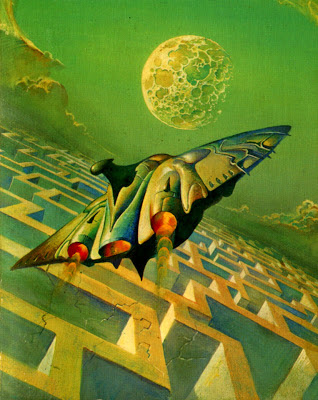The so-called Apotheosis Maze is an ancient structure of great power. It sits on an all but lifeless world on the seldom-traveled fringe of civilized space, yet still it draws visitors willing to accept it’s wordless challenge: Find the path through and perhaps attain godhood.
The maze covers nearly 20,000 m2. From a distance, it appears to be made of marble. Closer inspection reveals the material has an iridescent, oil-slick sheen when the light hits it right. Scanning reveals it to be much more than simple stone: There are patterns in its structure at the picometer (and possibly smaller) level: circuits repeating. The maze has a psionic presence, too--like faint, whispering voices in an adjacent room.
It’s said that no known weapon can damage the maze’s structure. It is uncertain whether anyone has ever actually tried. The guardians of the maze move quickly to stop any visitor who attempts violence against them or the maze. They wield quantum weapons, that are powerless cubes outside of their hands.
The guardians are tall, robed humanoids with enlarged craniums and skin as black as starless space. There are always three, though perhaps not always the same three. Their primary task seems to be to decide who may walk the maze from the supplicants present. They never allow more than five in, but the number varies; they often select fewer. Those they choose must divest themselves of weapons, equipment, and uplinks, and don simple robes before entering the maze.
Despite the fact that the maze is open to the sky, no one has ever been observed traversing it. It would appear that the maze's interior exists elsewhere. The vast majority of those who enter the maze never emerge. In fact, there is no recorded instance of anyone emerging--but many stories exist. All the stories suggest sophont beings who walk the maze transcend in some way--perhaps even to godhood. The hyehoon faithful believe their Mother Creator, Anat Morao, walked the maze before ascending into heaven where she continues to watch over her children. Some versions of Instrumentality doctrine mention attempts to walk the maze, either praising or condemning them. A conspiracy meme during the Radiant Polity held that the first psi mutant (an immortal being of immense power, supposedly) was born of a pregnant mother who had walked the maze.
The legends keep people trying. Some attempt to hedge their bets by finding a map of the maze. Such maps surface from time to time--and people have killed to get them--but as far as is known, they've all turned out to be fakes. A rumor current among spacers is that there’s a mendicant on a backwater world called Oriax, who carries the map (perhaps unknowingly) in his brain, but few have been able to locate the planet much less any miraculous vagrant.



.jpg)



































